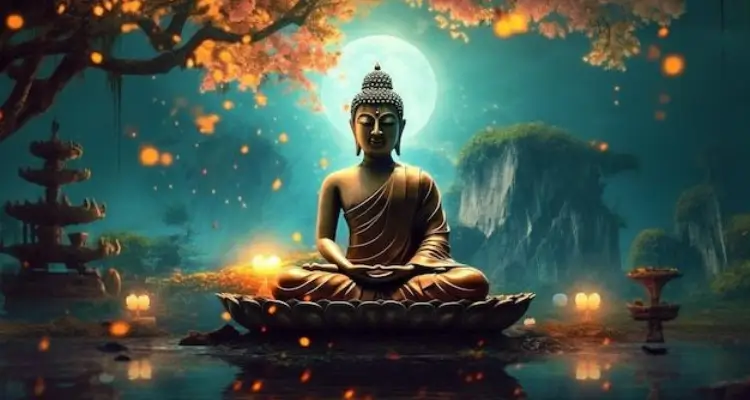Buddhism, one of the world’s oldest and most influential spiritual traditions, emerged in India in the 6th century BCE through the teachings of Siddhartha Gautama, known as the Buddha. He devoted his life to understanding human suffering and sharing his path to enlightenment. Rooted in ethical and meditative practices, his teachings transcended borders and eras, influencing millions of lives.
Initially, the teachings of the Buddha were transmitted exclusively orally. This practice aimed to preserve the authenticity of the messages, allowing his disciples to memorize and recite them. However, oral transmission also led to varied interpretations and differences in how the teachings were taught and practiced across different regions.
Approximately 300 years after the Buddha’s death, his teachings began to be written down on palm leaves. During an important council, these texts were compiled into what became known as the Pali Canon, consolidating the foundations of Buddhism. This transcription marked the beginning of a new era for the Buddhist tradition, enabling its preservation and expansion.
This article aims to explore the fascinating development of major Buddhist schools, their unique characteristics, and how they contributed to shaping the Buddhism we know today. From Theravada, known as the “path of the elders,” to more recent schools like Zen and Nichiren, we will journey through time and traditions to better understand the richness and diversity of Buddhism.
The Historical Context of the Buddha’s Teachings
Oral transmission of teachings and the preservation of sutras
After attaining enlightenment, the Buddha dedicated the rest of his life to sharing teachings that could help alleviate human suffering. During his lifetime, however, the practice of writing down teachings was not yet established. Therefore, the Buddha’s disciples adopted oral transmission as the primary method for preserving and spreading his words. This practice, known as the tradition of recited sutras, relied on rigorous memorization and mnemonic techniques to ensure that the teachings were passed down from generation to generation with minimal distortion.
Transcription of teachings on palm leaves 300 years after the Buddha’s death
As Buddhism expanded to different regions over the centuries, it became increasingly clear that recording the teachings in written form was necessary to prevent their loss due to regional variations or errors in oral transmission. Around 300 years after the Buddha’s death, during Emperor Ashoka’s reign, efforts began to transcribe the teachings onto palm leaves, a common writing material of the time. This monumental endeavor marked the beginning of the written preservation of the Buddhist legacy, providing greater accessibility and consistency in the teachings.
Formation of the Pali Canon during the first council
The first significant milestone in organizing the Buddha’s teachings occurred during the First Buddhist Council, held shortly after his death. During this council, hundreds of monks gathered to recite and consolidate the oral teachings. It was in this context that the Pali Canon began to take shape, bringing together the discourses attributed to the Buddha and monastic rules into a structured collection. The Pali Canon became the foundation of Theravada Buddhism and is widely recognized as one of the earliest records of the Buddha’s words.
The Teachings of the Elders and the Emergence of the First School (Theravada)
Introduction to the “Teachings of the Elders” (Sthaviravada)
After the Buddha’s passing, his teachings began to be organized and systematized by his disciples to ensure their preservation and authenticity. One of the earliest movements in Buddhism was known as “Sthaviravada,” meaning “Teachings of the Elders.” This name reflects the practitioners’ emphasis on adhering closely to the original words and intentions of the Buddha, maintaining a faithful connection to his tradition.
The Structure of the Three Baskets (Tripitaka)
One of the major contributions of the “Teachings of the Elders” was the compilation of the Buddha’s teachings into a structure known as the “Three Baskets” (Tripitaka):
- Sutras: These contain the Buddha’s original discourses, recorded to guide practitioners on the path to enlightenment.
- Vinaya: This section includes rules and guidelines for monastic life, emphasizing discipline and harmony among monks.
- Commentaries: These are interpretations and analyses by ancient masters, providing deeper insights into the sutras and Buddhist practice.
Theravada School
The Theravada school, derived from Sthaviravada, means “The Way of the Elders” and is considered the oldest surviving lineage of Buddhism. It values the purity of the original teachings and emphasizes practical application of monastic discipline and meditation as paths to enlightenment.
The Theravada school spread widely throughout Southeast Asia, becoming the predominant form of Buddhism in countries such as Burma (Myanmar), Sri Lanka, and Thailand. In these regions, it has shaped local culture and spirituality, playing a central role in the daily lives of communities.
Mahayana Buddhism: The Great Vehicle
Emergence and Main Characteristics
Mahayana Buddhism, known as “The Great Vehicle,” emerged approximately four centuries after the Buddha’s death as a response to perceived limitations in the Theravada path. Unlike the more individualistic approach of Theravada, Mahayana emphasizes that enlightenment is accessible not only to monks but also to laypeople, expanding the reach of the Buddha’s teachings.
Mahayana followers criticized Theravada for being overly conservative and restrictive, referring to it as “Hinayana” or “Small Vehicle.” However, Mahayana retained respect for the original teachings while introducing a more inclusive and compassionate approach to practice.
Key Texts and Teachings
Mahayana is characterized by the creation of new sutras, considered by its adherents as extensions and elaborations of the Buddha’s teachings. Among the most significant are:
- Lotus Sutra: This text emphasizes that all beings have the potential to attain enlightenment.
- Vimalakirti Sutra: A teaching that highlights wisdom and compassion, showing that even laypeople can possess profound spiritual realization.
Geographic Spread
Mahayana Buddhism spread widely across Asia, influencing various cultures and local traditions. It became predominant in regions such as Tibet, Japan, China, Korea, and Vietnam, shaping the art, philosophy, and spirituality of these societies.
Subdivisions of Mahayana
Mahayana encompasses various traditions and schools, including Vajrayana Buddhism, also known as “The Diamond Vehicle.” This subgroup combines esoteric and ritualistic practices, emphasizing advanced meditations, mantras, and visualizations to accelerate the path to enlightenment.
Vajrayana: The Diamond Vehicle
Development in Tibet and External Influences
Vajrayana, known as “The Diamond Vehicle,” is a branch of Mahayana Buddhism that developed primarily in Tibet from the 7th century onward. Its formation was influenced by both Hindu Tantra and the indigenous Tibetan spiritual tradition, the Bon Church. This unique blend resulted in a more ritualistic and esoteric approach, focusing on accelerating the path to enlightenment.
The integration of cultural and religious elements allowed Vajrayana to adapt and flourish in Tibet, becoming an essential component of Tibetan spiritual identity.
Key Practices and Defining Characteristics
Some of the defining practices of Vajrayana include:
- Emphasis on Lamas: Lamas (spiritual teachers) play a central role, being considered indispensable guides for the disciple’s spiritual progress.
- Guru Yoga: This practice involves devotion to the guru as a manifestation of the Buddha, symbolizing the union of wisdom and compassion.
Additionally, Vajrayana employs mantras, mandalas, and visualizations as powerful tools to transform the mind and achieve enlightenment.
Differences and Similarities with Mahayana
Although Vajrayana is a branch of Mahayana, it exhibits notable differences in its approach. While Mahayana emphasizes compassion and wisdom as pillars for enlightenment, Vajrayana incorporates esoteric methods and advanced ritual practices. However, both traditions share the ultimate goal of liberating all beings from suffering and attaining Buddhahood.
Nichiren Buddhism: The Centrality of the Lotus Sutra
Emergence in Japan in the 12th Century
Nichiren Buddhism originated in Japan in the 12th century, founded by the monk Nichiren Daishonin. He emphasized the Lotus Sutra as the pinnacle of Buddha’s teachings, believing it contained the universal truth for the salvation of all beings. Nichiren asserted that practicing his teachings was the key to achieving both inner peace and world harmony.
Main Doctrines and Practices
The core practice of Nichiren Buddhism is chanting the mantra “Nam-Myoho-Renge-Kyo,” which signifies devotion to the Lotus Sutra and belief in its transformative power. This practice is complemented by the use of a sacred scroll called Gohonzon, representing enlightenment.
Another distinctive feature of Nichiren Buddhism is its division into various schools, such as Soka Gakkai and Nichiren Shu, which interpret and apply the teachings differently while maintaining the chanting of the mantra as a common practice.
Controversies with Traditional Buddhism
Nichiren Buddhism has often faced controversies due to Nichiren’s strong stance against other Buddhist traditions. He criticized schools like Pure Land Buddhism and Zen, arguing that only the Lotus Sutra encapsulated the true essence of the Dharma. This confrontational approach sparked conflicts but also solidified Nichiren Buddhism’s unique place in Japan’s religious landscape.
Other Buddhist Schools and Their Characteristics
Shingon School
The Shingon School is renowned for its esoteric practices, emphasizing secret rituals and a deep connection to tantric teachings. Introduced to Japan by the monk Kukai (also known as Kobo Daishi), Shingon combines meditative practices, mantra chanting, and visualization to achieve enlightenment. A hallmark of this school is the use of mandalas, representing the cosmos and aiding practitioners in connecting with the divine.
Tendai School
The Tendai School, introduced to Japan by Saicho, played a significant role in the development of Japanese Buddhism. It integrates various Buddhist teachings and practices, including meditation and sutra recitation, with a particular focus on the Lotus Sutra. Historically, Tendai influenced the emergence of other traditions such as Zen and Pure Land Buddhism. Its inclusive approach sought to encompass different paths to enlightenment, adapting to the spiritual needs of diverse individuals.
Pure Land School (Amidism)
The Pure Land School, also known as Amidism, centers on devotion to Amitabha Buddha and the aspiration to be reborn in his Pure Land—a spiritual realm of peace and enlightenment. Its core practice is the nembutsu, the chanting of Amida’s name (Namu Amida Butsu), as an expression of faith and gratitude. Popular among lay practitioners, Amidism emphasizes the simplicity and accessibility of its teachings, making it one of the most widespread traditions in East Asia.
Zen Buddhism: The Direct Experience of Reality
Origins and Historical Evolution
Zen Buddhism originated in China during the 6th century, initially known as Chan, which was influenced by the practice of deep meditation. It was later introduced to Japan in the 12th century, where it became one of the leading Buddhist schools. The word “Zen” comes from the Chinese term “Chan,” meaning meditation. Zen differs from other schools by focusing directly on the immediate experience of reality, without the need for complex doctrines or extensive study of sutras. Over time, Zen spread to many parts of the world, becoming a highly regarded practice in various cultures.
Focus on Zazen Meditation
The central practice in Zen is seated meditation, known as zazen. Zazen is not merely a relaxation technique but a deep practice that aims to experience the present moment directly and realize the state of enlightenment. During zazen, practitioners sit in silence, keeping their minds attentive and observing thoughts without attachment. Through this practice, the goal is to transcend dualistic thinking and achieve unity with reality—an essential experience on the Zen path.
Syncretism with Other Schools and Diffusion in the West
Zen is characterized by its syncretism with other traditions and practices, incorporating influences from Taoism and Confucianism, and adapting to the cultural contexts where it spread. In Japan, Zen blended with other spiritual practices, such as Pure Land Buddhism and Tendai Buddhism. In the West, Zen gained popularity in the 20th century, particularly in the United States, where its simple and direct approach to practice was appreciated. Zen became a bridge between Eastern spirituality and Western psychology, offering a way to address the challenges of modern life.
Modern Contributions: Dialogue with Psychology and Science
In recent years, Zen Buddhism has engaged in dialogue with psychology, particularly cognitive-behavioral therapy (CBT). Zen meditation’s focus on mindful observation of thoughts and emotions has shown benefits for stress management, anxiety reduction, and increased well-being. Zazen practice has also been studied for its neuroscientific effects, with research indicating that Zen meditation can alter brain structures associated with emotional and cognitive well-being. This shows how Zen adapts and contributes to the understanding of the mind and mental health in the modern world.
Conclusion
Buddhism is a deeply rich and diverse spiritual tradition, with several schools emerging throughout its history, each contributing uniquely to the understanding and practice of Buddha’s teachings. From Theravada, with its focus on preserving the original teachings and the pursuit of personal enlightenment, to Mahayana, which broadened access to enlightenment for all beings, and Vajrayana, with its esoteric practices and secret rituals, each school offers a distinct view on how to attain awakening. Zen, with its emphasis on meditation, and schools like Nichiren, focusing on the recitation of the Lotus Sutra, are just a few examples of how Buddhism has diversified, offering different paths to its followers.
This diversity not only reflects the various cultures and contexts in which Buddhism has been established but also highlights the depth of Buddha’s teachings, which have adapted and evolved over the centuries. Buddhism has proven to be a spiritually relevant practice, crossing geographical and cultural boundaries, impacting millions of people around the world. Its lessons on compassion, wisdom, and the path to inner peace continue to resonate powerfully in global society.
We invite you to reflect on the teachings of Buddhism and how they can be applied in your everyday life. Regardless of which school resonates most with you, Buddhism offers valuable lessons on how to deal with life’s difficulties, cultivate the mind and heart, and seek true inner freedom. It is an invitation to self-awareness and personal transformation, with the potential for a deep and enriching journey.

































